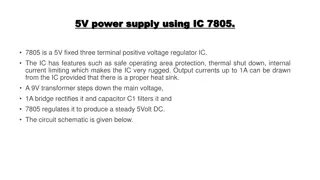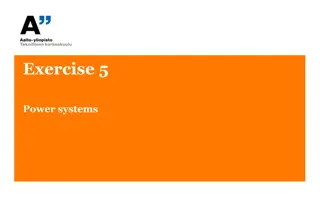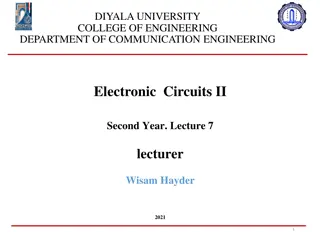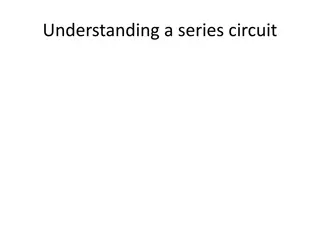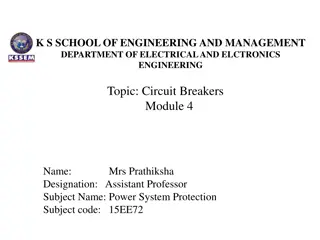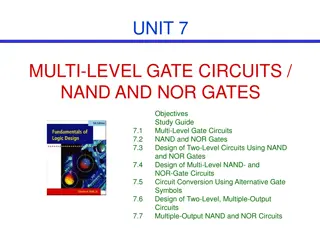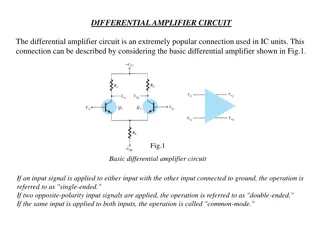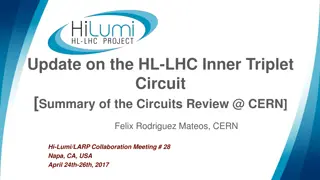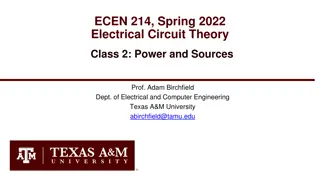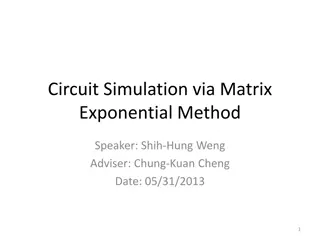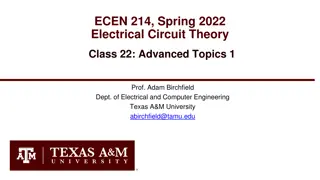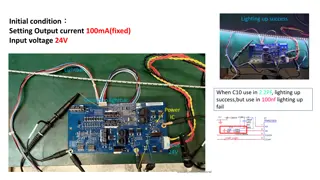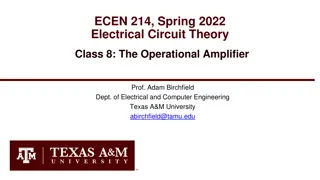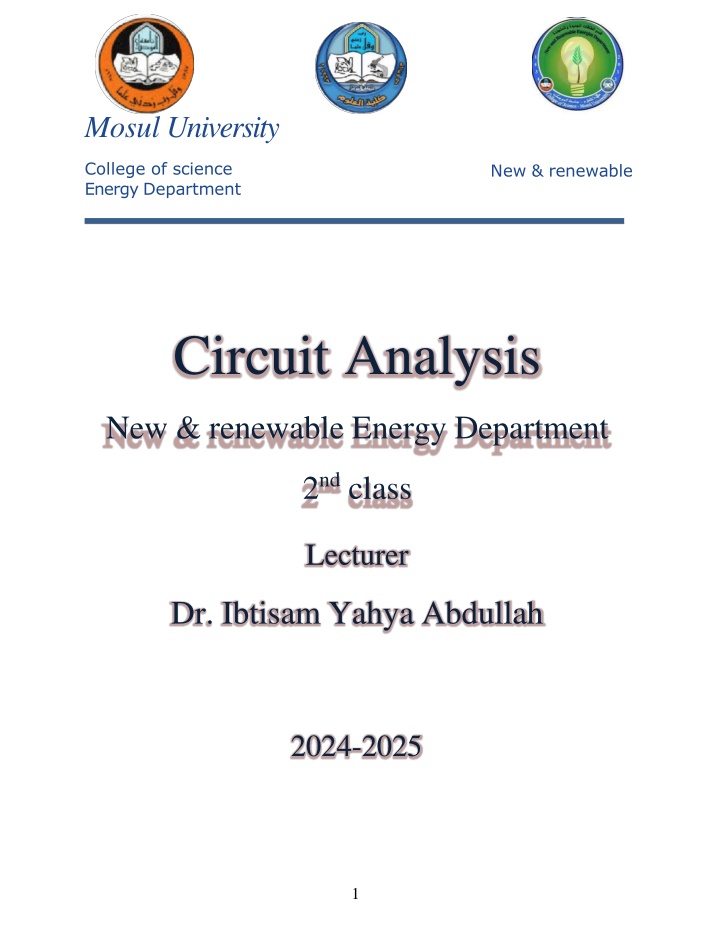
Electric Circuit Fundamentals and Analysis Techniques
Explore the basics of electric circuits, including circuit components, open and short circuits, circuit analysis methods like Kirchhoff's laws, and theorems like Thevenin's theorem. Learn the distinction between active and passive elements, and understand the implications of open and short circuits in electrical systems.
Download Presentation

Please find below an Image/Link to download the presentation.
The content on the website is provided AS IS for your information and personal use only. It may not be sold, licensed, or shared on other websites without obtaining consent from the author. If you encounter any issues during the download, it is possible that the publisher has removed the file from their server.
You are allowed to download the files provided on this website for personal or commercial use, subject to the condition that they are used lawfully. All files are the property of their respective owners.
The content on the website is provided AS IS for your information and personal use only. It may not be sold, licensed, or shared on other websites without obtaining consent from the author.
E N D
Presentation Transcript
Mosul University College of science Energy Department New & renewable Circuit Analysis New & renewable Energy Department 2nd class Lecturer Dr. Ibtisam Yahya Abdullah 2024-2025 1
1. Simple Electrical Circuit 2. Open, close and Short Circuit 3. Basic Terminologies 4. Circuit Analysis 5. Series Circuits 6. Voltage Sources in Series 7. Kirchhoff s Voltage Law 8. Interchanging Series Elements 9. Voltage Divider Rule 10.Parallel Elements 11.Total Conductance and Resistance 12.Parallel Circuits 13.Kirchhoff s Current Law 14.Current Divider Rule 15.Problems 16.Branch-Current Analysis 17.Mesh & super mesh Analysis 18.Nodal Analysis 19.Superposition Theorem 20.Thevenin's Theorem 2
Simple Electrical Circuit The word circuit comes from the Latin root circ, meaning ring or around . An electrical circuit consists of at least one ring or loop through which current flows. For example, if we have a battery attached to a lamp as in Figure 1, the current exits the battery, flows through the lamp, and then returns to the other side of the battery creating a loop or completed circuit. Without a path back to the battery, the current will not flow. Thus, if we cut one of the wires connecting the battery and lamp, there is no path for current, and no current flows. This is called an open circuit and is a common fault that occurs when electronic systems are dropped or struck forcefully. This will tend to render the circuit unusable. In this example, the lamp will not illuminate. The opposite of the open circuit is the short circuit. In a short circuit, an unintended alternate path for current flow exists, which can also create a malfunction. In the case of our battery and lamp, a short circuit can occur if a piece of wire or metal accidentally falls across the terminals of the lamp. The current would have a high conductance (i.e., low resistance) path around the lamp. The vast majority of the current would take this low resistance path instead of the higher resistance path presented by the lamp. The result would be that the lamp would not light. In either the open or short case, the light does not function but there is an important difference: for the short circuit, excessive current will flow out of the battery because there is little to resist the flow of current. Thus, the battery will be drained very quickly. For the open, no current flows, and thus the battery is not drained. Figure 1 Electric circuit 3
There are two types of elements found in electric circuits: active elements and passive elements. An active element is capable of generating energy while a passive element is not. Examples of passive elements are resistors, capacitors, and inductors. Typical active elements include generators, batteries, and operational amplifiers. Our aim in this section is to gain familiarity with some important active elements. Open, clos and Short Circuit A closed path following an electric current is known as an electric circuit or simply circuit. An electric circuit consists of a number of circuit components such as resistors, inductors, capacitors, etc. Sometimes in an electric circuit, two undesirable conditions occur namely open circuit and short circuit. Basically, these two states of an electric circuit are considered as faults in the circuit and hence are undesirable. In this article, we will highlight the major differences between an open circuit and a short circuit. What is an Open Circuit? As its name suggests, an open is a break in the path of the current in the circuit. Therefore, an open circuit can be defined as a break or interruption in the circuit path. An open circuit may be as a result of a component failure or disconnection of a conducting path such as breaking of a conducting wire. For any electrical circuit, by Ohm s law, we have, ? ? ? = Now in case of open circuit, the current through the circuit is zero, thus, ? ? = = 0 Hence, ideally an open circuit offers infinite resistance in the path of electric current. The effect of open circuit in a series circuit and a parallel circuit is different. That is, in a series circuit following symptoms can be observed The total circuit current becomes zero. There is no voltage drop across the components which are normal. The total supply voltage will appear across the open circuited terminals. The terminal voltage of source may measure higher than the normal. Following are the effects of an open circuit in a parallel circuit The total circuit will decrease. The current through the open circuit branch becomes zero, while the operation of the branches without open circuit will be normal. What is a Short Circuit? In any electrical circuit, the unwanted path of low resistance is called short circuit. When a short circuit occurs in an electric circuit, the total resistance of the circuit becomes very low. Consequently, the total circuit current becomes greater than the normal which may cause damage of other healthy devices in the circuit, Figure 2 shoe the open and short circuits. 4
Figure 2 open & short circuits The common reasons of occurrence of short circuit in an electric circuit are insulation failure, components get shorted, etc. The effect of short circuit in both series circuits and parallel circuit is almost same. Sometimes, the short circuits are result in electric fire, explosion, etc. Mathematically, by Ohm s law, we have, ? ? ? = When there is a short circuit in the circuit, the circuit current becomes infinitely high, thus, ? ? = = 0 Hence, a short circuit ideally offers a resistance of zero ohms in the path of current. Differences between Open Circuit and Short Circuit Both open and short circuits are unwanted conditions in an electric circuit and are treated as a fault in the circuit. However, there are several differences between open and short circuit that are listed in the following table Differences between Open Circuit and Short Circuit Both open and short circuits are unwanted conditions in an electric circuit and are treated as a fault in the circuit. However, there are several differences between open and short circuit that are listed in the following table. Open Circuit Short Circuit Basis of Difference Definition When there is a break in the conducting path of an electric circuit, it is called open circuit. When there is an unwanted path of very low resistance in an electric circuit is called short circuit. The resistance of an open circuit is tending to infinity. Ideally, it is considered infinity. The resistance of the short circuit is tending to zero, and ideally it is taken zero. Resistance Circuit current The current flowing through an open circuit is zero. The current flowing through a short circuit is infinite. Voltage The voltage across the open circuit is equal to the voltage of the supply. The voltage of a short circuit is ideally zero, because the resistance of an ideal short circuit is taken zero. 5
Causes In practice the main causes of an open circuit are failure of device or component, breaking of the conducting wire, etc. The causes of short circuit are insulation failure, shorting of component, etc. Practical applications Open circuit may also be used in a right way, as in case of an OFF switch. Sometimes , the short circuits are also used in a useful way such as, to short the secondary winding of a current transformer during maintenance, etc. Conclusion The most significant difference between an open circuit and a closed circuit is that an open circuit has a resistance tending to infinite, whereas a short circuit has a resistance tending to zero. Basic Terminologies An electric circuit is a collection of interconnected multi-terminal electrical devices (also referred to as circuit elements). Conventional circuit analysis focuses on devices that can be modeled as two-terminal devices, namely, a circuit element with two leads coming out of it. Examples of two-terminal devices include independent sources (e.g., a battery), simple resistors, capacitors, inductors and diodes. In practice, there are also many devices that have more than two terminals. Typical such examples are transistors, transformers, and operational amplifiers. In circuit analysis, those multi-terminal devices are typically modeled as twoterminal devices with dependent sources. Before we proceed to show some circuit analysis examples, we shall define some terminologies first: Node: a node is a point of connection between two or more circuit elements. Branch: a branch is a portion of the circuit that consists of one circuit element and its two terminal nodes. Loop: a (closed) loop is a sequence of connected branches that begin and end at the same node. Branch Current: a branch current is the current that flows through the electrical device of the branch. Branch Voltage: a branch voltage is the potential difference between the two terminal nodes of the electrical device of the branch. 6
Node Voltage: a node voltage is the potential difference between a designated node and the reference node. Loop Current: a loop current is the current that flows through a closed loop. Note that loop current is different from branch current if that branch is common to two or more loops. It is important to note that conventional circuit analysis assumes that all wires (or lead) are perfect conductors, namely, the lumped parameter circuit model. Therefore, no energy is lost when currents flow through the wires, and non-zero branch voltages occur only across a circuit element (a wire itself is not a circuit element). In circuit analysis, each branch has two branch variables, i.e., branch voltage and branch current. These are algebraic variables, thus they have signs associated with their values. A circuit is completely characterized if all the branch variables are known. Thus the objective of circuit analysis is to solve for all branch voltages and branch currents. Circuit Analysis In principle, three sets of equations are sufficient to perform circuit analysis for any circuit, which are Kirchoff s current law (KCL), Kirchoff s voltage law (KVL), and branch element equations (e.g., Ohm s law). The KCL and KVL characterize the circuit topology, i.e., how the circuit elements are connected. In contrast, the branch element equation characterizes the circuit element's physical property, specifically, the current-voltage relation. Series Circuits A circuit consists of any number of elements joined at terminal points, providing at least one closed path through which charge can flow. The circuit of Fig. 3(a) has three elements joined at three terminal points (a, b, and c) to provide a closed path for the current I. 7

